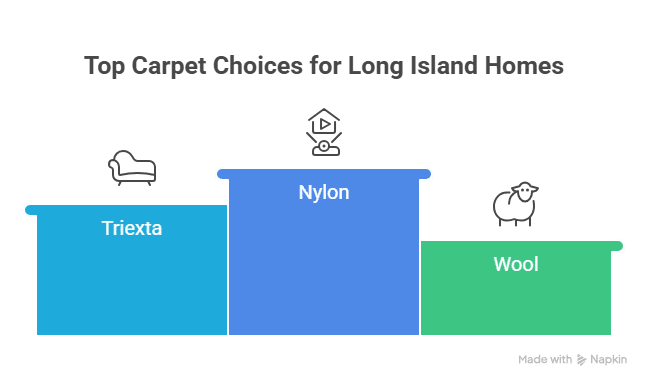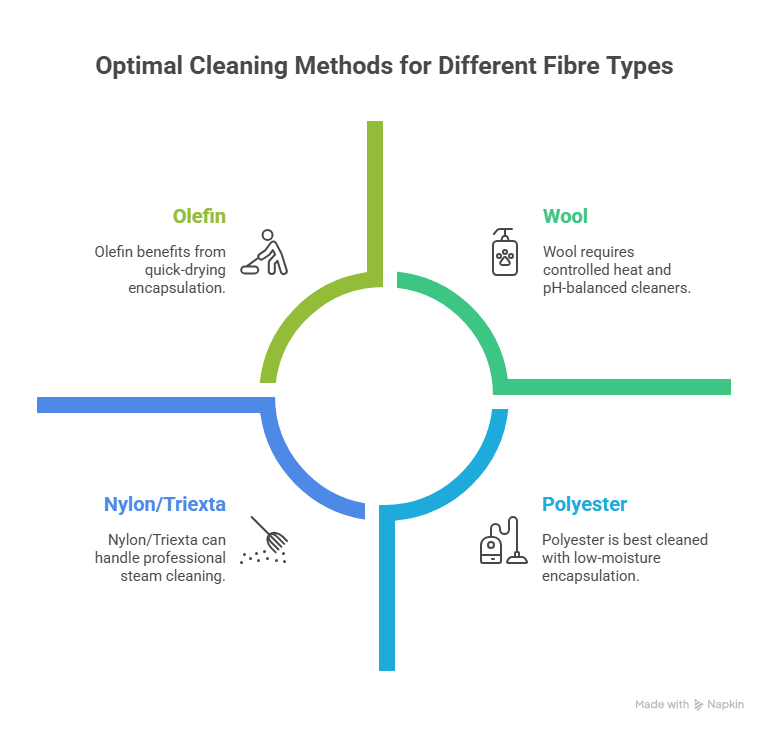Table of Contents
If you’ve ever stepped barefoot onto a soft carpet after a Long Island beach day — only to find it gritty with sand or smelling faintly of salt — you already know that flooring here lives a harder life than most. Between humid summers, winter slush, coastal air, and family foot traffic, your carpet quietly takes the beating.
Choosing the right carpet fibre isn’t just about comfort or color — it’s a decision that affects how long your flooring lasts, how easy it is to clean, and even your home’s air quality.
In this guide, we’ll break down which carpet materials (nylon, polyester, triexta, wool, and olefin) perform best for Long Island’s unique climate. You’ll discover how humidity, salt, and lifestyle impact your carpet’s durability, why solution-dyed nylon and triexta are homeowner favorites, and how to match each fibre to your family’s needs — from beach cottages in Montauk to busy homes in Garden City.
Why Long Island’s Climate Is a Carpet’s Worst Enemy
Humidity, Salt, and Seasonal Shifts
Long Island’s humid summers are relentless. Moisture creeps into the backing of carpets, creating a breeding ground for mildew and that “musty” smell no candle can hide.
Come winter, calcium chloride from driveways mixes with melting snow and seeps into your entry rugs, leaving white crusty stains that stiffen the fibres.
If you live anywhere from Huntington to Montauk, you already know: what you track in from the yard ends up embedded in the pile.
Understanding Carpet Fibre Types
Choosing carpet fibre is a bit like choosing a car — each has its own performance level, comfort, and maintenance cost.
| Fibre Type | Strengths | Weaknesses | Ideal Use |
|---|---|---|---|
| Nylon | Durable, resilient, stain resistant | Slightly pricier | High-traffic areas, stairs |
| Polyester (PET) | Soft, vibrant colors, eco-friendly | Can crush easily | Bedrooms, guest rooms |
| Triexta (SmartStrand) | Great stain protection, soft texture | Slightly less resilient than nylon | Family & living rooms |
| Wool | Natural, breathable, long-lasting | Expensive, sensitive to moisture | Formal or low-traffic spaces |
| Olefin (Polypropylene) | Moisture & bleach resistant | Crushed appearance under weight | Basements, indoor-outdoor areas |
Top Carpet Fibre Choices That Perform Best in Long Island Homes

- Nylon — The Workhorse 🧼
If Long Island had a “carpet MVP,” it’d be nylon. It bounces back after pressure, resists sand abrasion, and handles humidity well.
Go for solution-dyed nylon carpet — it locks in color at the molecular level, making it bleach-resistant and perfect for coastal homes.
- Triexta — Soft but Strong
Triexta, or SmartStrand, has the warmth of polyester but added toughness. Families with kids and Labradors will love it. Even red wine wipes off with mild detergent — no panic cleaning required.
- Wool — The Heritage Choice
Nothing beats the warmth of wool underfoot on a cold Babylon morning. It’s naturally stain-resistant and self-extinguishing, but needs care — no harsh chemicals or high-alkaline cleaners.
If you’re set on sustainability, wool carpet cleaning tips from CRI recommend periodic professional maintenance using neutral pH solutions.
Matching Carpet Fibre to Your Lifestyle
| Lifestyle | Recommended Fibre | Why It Works |
|---|---|---|
| Busy families with kids/pets | Nylon or Triexta | Tough, stain resistant, hides tracks |
| Waterfront & beach homes | Solution-dyed Nylon | Fights salt, sun fade, and sand abrasion |
| Low-traffic spaces | Polyester | Plush feel, affordable |
| Basements or humid rooms | Olefin | Moisture-proof and easy to clean |
Construction & Density: The Hidden Players
It’s not just the fibre — it’s how it’s built.
- Twist: More twists = more resilience.
- Density: Tight yarn packing prevents matting.
- Face weight: Indicates total fibre mass — higher usually means better wear.
When comparing, don’t just go by “feel.”
A 40 oz dense nylon can outlast a soft, loose 60 oz polyester any day.
Padding: The Underrated Hero
A carpet’s comfort and life span depend heavily on what’s underneath.
Opt for 8–10 lb high-density padding, ideally with antimicrobial properties to deter mold — especially vital for Long Island basements.
If you live near the coast, choose moisture-resistant underlayment or a vapor barrier pad to prevent subfloor dampness from creeping up.
How Different Carpet Fibres React to Cleaning Methods (and Why It Matters)

Hot Water Extraction (HWE) vs. Low-Moisture (VLM)
- Nylon/Triexta: Handles professional steam cleaning every 12–18 months.
- Polyester: Better suited for low-moisture encapsulation cleaning.
- Wool: Needs controlled heat and pH-balanced cleaners.
- Olefin: Quick-drying encapsulation is ideal.
(For Long Island residents, professional carpet cleaning every spring and fall is optimal — humidity and salt residue are lowest then.)
Everyday Maintenance Checklist
- Vacuum twice weekly with a HEPA filter vacuum.
- Treat salt or wine stains immediately.
- Rotate rugs and furniture every 6 months.
- Schedule pro deep cleaning once a year.
Color and Pattern: More Than Aesthetic
Sand and pet hair love light-colored carpets — they blend invisibly until it’s too late.
Choose speckled, heathered, or low-pile patterns to disguise buildup between cleans.
Mid-tone hues — soft grays, beige-sands, or stone — match Long Island’s natural palette while forgiving everyday mess.
Eco-Friendly and Health Considerations
Modern homeowners care about sustainability. Look for:
- Low-VOC certification (EPA Guide)
- Recycled PET polyester options
- Wool sourced from cruelty-free farms
- Carpets with CRI Green Label Plus seal
Budgeting: Where to Save, Where to Splurge
| Space | Fibre | Price Range (Installed) | Lifespan |
|---|---|---|---|
| Bedroom | Polyester | $3–$6 per sq.ft | 8–10 yrs |
| Living Room | Triexta | $5–$8 per sq.ft | 10–15 yrs |
| Stairs & Hallways | Nylon | $6–$10 per sq.ft | 15–20 yrs |
| Basement | Olefin | $3–$5 per sq.ft | 5–8 yrs |
Common Carpet Mistakes Homeowners Make
❌ Choosing by softness alone
❌ Ignoring humidity and salt exposure
❌ Skipping professional cleanings
❌ Using harsh detergents on wool
❌ Forgetting proper padding
A carpet is only as strong as its weakest decision — don’t let the pad or cleaner ruin a perfect investment.
FAQ's
1. What’s the most durable carpet fibre for Long Island homes?
Solution-dyed nylon — it resists sand, moisture, and bleach.
2. Is wool carpet high maintenance?
Not if maintained with wool-safe cleaners and controlled humidity.
3. What’s best for beach houses?
Low-pile solution-dyed nylon or olefin loop — both shrug off salt and grit.
4. How often should I deep-clean?
Every 12–18 months, ideally during spring or fall.
5. Can carpets improve indoor air quality?
Yes — modern low-VOC carpets trap dust until vacuumed, improving air health when maintained properly.




